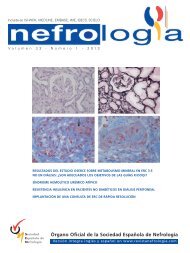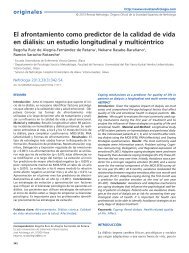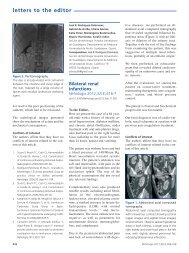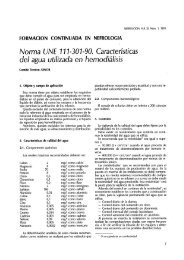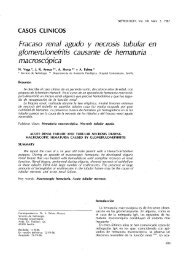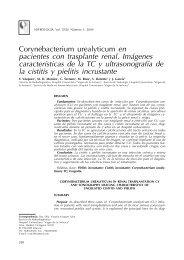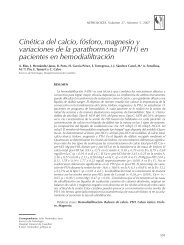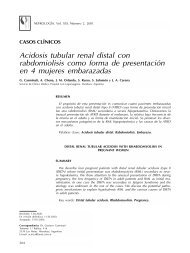PDF Número - NefrologÃa
PDF Número - NefrologÃa
PDF Número - NefrologÃa
You also want an ePaper? Increase the reach of your titles
YUMPU automatically turns print PDFs into web optimized ePapers that Google loves.
comentarios editoriales<br />
S. Cigarrán Guldrís. Aplicaciones futuras de la bioimpedancia vectorial<br />
dialysis: vector bioelectric impedance analysis. Clin Nephrol<br />
2010;73:300-8.<br />
38. Pillon L, Piccoli A, Lowrie EG, Lazarus JM, Chertow GM. Vector<br />
length as a proxy for adequacy of ultrafiltration in hemodialysis. Kidney<br />
Int 2004;66:1266-71.<br />
39. Dumler F. Best method for estimating urea volume of distribution:<br />
comparison of single pool variable volume kinetic modeling measurements<br />
with bioimpedance and anthropometric methods. ASAIO J<br />
2004;50:237-41.<br />
40. Teruel JL, Álvarez Rangel JL, Fernández Lucas M, Merino JL. Control<br />
de la dosis de diálisis mediante dialisancia iónica y bioimpedancia.<br />
Nefrologia 2007;27:69-73.<br />
41. Cigarrán S, Barril G, Bernis C, Cirugeda A, Herrainz I. Evaluación del<br />
estado nutricional de los pacientes renales y ajuste del peso seco en<br />
CAPD y HD: papel de la bioimpedancia. Electron J Biomed<br />
2004;1:16-23.<br />
42. Plum J, Schoenicke G, Kleophas W, Steffens F. Comparison of body<br />
fluid distribution between chronic haemodialysis and peritoneal<br />
dialysis patients assessed by biophysical and biochemical methods.<br />
Nephrol Dial Transplant 2001;16:2378-85.<br />
43. Piccoli A, for the Italian CAPD-BIA study group. Bioelectrical impedance<br />
vector distribution in peritoneal dialysis patients with different<br />
hydration status. Kidney Int 2004;65:1050-63.<br />
44. Piccoli A, for the Italian hemodialysis-Bioelectrical impedance analysis<br />
(HD-BIA) study group. Identification of operational clues to dry<br />
weight prescription in hemodialysis using bioimpedance vector<br />
analysis. Kidney Int 1998;53:1036-48.<br />
45. Young GA, Kopple JD, Lindholm B. Nutritional assessment of continuous<br />
ambulatory peritoneal dialysis. An international study. Am J<br />
Kidney Dis 1991;17:462-71.<br />
46. Jager KJ, Merkus MP, Huisman RM. Nutritional status over time in hemodialysis<br />
and peritoneal dialysis. J Am Soc Nephrol 2001;12:1272-<br />
9.<br />
47. Cigarrán S, Barril G, Cirugeda A, Bernis C. Hypoalbuminemia is also<br />
a marker of fluid excess determined by bioelectrical impedance parameters<br />
in dialysis patients. Ther Apher Dial 2007;11:114-20.<br />
48. Mittman N, Avran MM, Oo KK. Serum prealbumin predicts survival<br />
in hemodialysis and peritoneal dialysis: 10 years of prospective observation.<br />
Am J Kidney Dis 2001;38:1358-64.<br />
49. Oliveira CM, Kubrusly M, Mota RS, Silva CAB. The phase angle and<br />
mass cell as markers of nutritional status in hemodialysis patients.<br />
J Ren Nutr 2010;20:314-20.<br />
50. Muschnik R, Fein PA, Mittman N, Goel N. Relationship of bioelectrical<br />
impedance parameters to nutrition and survival in peritoneal<br />
dialysis patients. Kidney Int 2003;64:S53-S56.<br />
51. Fernández Reyes MJ, Bajo A, Del Peso G, Regidor D. Extracellular<br />
volume expansion caused by protein malnutrition in peritoneal dialysis<br />
patients with appropriate salt and water removal. Perit Dial Int<br />
2008;28:407-12.<br />
52. Vicente Martínez M, Martínez-Ramírez L, Muñoz R, Ávila M. Inflammation<br />
in patients on peritoneal dialysis is associated with increased<br />
extracellular fluid volume. Arch Med Res 2004;35:220-4.<br />
53. Cigarrán S, Coronel F, Barril G, Lamas J. Malnutrición en diálisis<br />
peritoneal. Nuevo concepto definido por bioimpedancia eléctrica.<br />
Nefrologia 2008. XXXVIII Reunión Anual de la SEN. Abstract 243<br />
[poster].<br />
642<br />
54. Kalantar-Zadeh K, Abbott KC, Salahudeen Ak. Survival advantages<br />
of obesity in dialysis patients. Am J Clin Nutr 2005;81:543-54.<br />
55. Kalantar-Zadeh K, Streja E, Kovesdy CC, Oreopoulos A. The obesity<br />
paradox and mortality associated surrogates of body size and muscle<br />
mass in patients receiving hemodialysis. Mayo Clin Proc<br />
2010;85:991-1001.<br />
56. Fusaro M, Munaretto G, Urso M, Bonadonna A. Severe obesity in<br />
hemodialysis: the utility of bioimpedance vector analysis. Nephrol<br />
Dial Transplant 2001;16:1273-6.<br />
57. Guida B, De Nicola L, Pecoraro P, Trio R. Abnormalities of bioimpedance<br />
measures in overweight and obese hemodialyzed patients. Int<br />
J Obes 2001;25:265-72.<br />
58. Lim VS, Ikizler A, Raj DSC, Flanigan MJ. Does hemodialysis increase<br />
protein breakdown? Dissociation between whole-body amino acid<br />
turnover and regional muscle kinetics. J Am Soc Nephrol<br />
2005;16:862-8.<br />
59. Bohé J, Rennie MJ. Muscle protein metabolism during hemodialysis.<br />
J Ren Nutr 2006;16:3-16.<br />
60. Veeneman JM, Kingma HA, Boer TS, Stellaard F. Protein intake during<br />
hemodialysis maintains a positive whole body protein balance<br />
in chronic hemodialysis patients. Am J Physiol Endocrinol Metab<br />
2003;284:954-65.<br />
61. Cano NJM, Leverve XM. Intradialytic nutritional support. Curr Opin<br />
Clin Nutr Metab Care 2008;11:147-51.<br />
62. Basile C, Libuti P, Di Turo AL. Bioimpedance and the duration of the hemodialysis<br />
session. ASAIO J 2011;57:DOI: 10.1097/MAT.0b013e31821f2296.<br />
63. Wong HS, Boey LM, Morad Z. Body composition by bioelectrical impedance<br />
analysis in renal transplant recipients. Transpl Proc<br />
2004;36:2186-7.<br />
64. Cigarrán S, Coronel F, Bernis C, García Trio G, Saavedra J, Selgas<br />
R. Phase angle, body cell mass and Na-K exchange obtained from<br />
Bioelectrical Impedance Vectorial Analysis (BIVA) in renal transplant<br />
patients (RTR). J Am Soc Nephrol 2005;16:177 [abstract 819A].<br />
65. Chan M, Patwardhan A, Rayan C, Chadban S. Evidenced-based guidelines<br />
for the nutritional Management of adult kidney transplant<br />
recipients. J Renal Nutr 2011;21:47-51.<br />
66. Sue Kent P. Issues of obesity in kidney transplantation. J Renal Nutr<br />
2007;17:107-13.<br />
67. Dumler F, Kilates C. Metabolic and nutritional complications of renal<br />
transplantation. J Renal Nutr 2007;17:97-102.<br />
68. Lentine K, Axelrod D, Abbott KC. Interpreting body composition in<br />
kidney transplantation: weighing candidate selection, prognostication,<br />
and interventional strategies to optimize health. Clin J Am Soc<br />
Nephrol 2011;6:1238-40.<br />
69. Molnar M, Czira ME, Rudas A, Ujszaski A, Lindner A. Association of<br />
the malnutrition-inflammation score with clinical outcomes in kidney<br />
transplant recipients. Am J Kidney Dis 2011;58:101-8.<br />
70. Moreau K, Chaveau P, Martin S, El-Haggan W. Long-term evolution<br />
of body composition after renal transplantation: 5 years survey. J Renal<br />
Nutr 2006;16:291-9.<br />
71. Coroas A, De Oliveira JGG, Sampaio S, Borges C. Body composition<br />
assessed by impedance changes very early with declining renal graft<br />
function. Nephron Physiol 2006;104:115-20.<br />
72. Coroas A, De Oliveira JGG, Sampaio S, Borges C. Postrenal transplantation<br />
body composition: different evolution depending on gender.<br />
J Renal Nutr 2007;17:151-6.<br />
Nefrologia 2011;31(6):635-43



